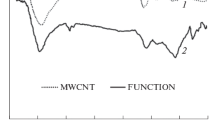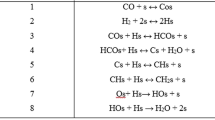Abstract
In this work, the nanostructure catalyst of Co–Ru/CNTs is prepared by chemical reduction technique. Then, a set of catalytic experiments are designed and conducted for the Fischer–Tropsch synthesis (FTS) using the synthesized catalyst in a fixed bed reactor. The physical and chemical properties of the support and the synthesized catalyst were determined using the BET, XRD, H2–TPR, TEM, and H2-chemisorption characterization techniques. Based on the alkyl mechanism and using the Langmuir–Hinshelwood–Hougen–Watson (LHHW) isotherm, a kinetic model is developed for FTS. In most of the previous kinetic models, the primary reactions have merely been used, but in the current derivation of the developed kinetic model, the secondary reactions (adsorption, hydrogenation and chain-growth) and re-adsorption of primary olefins at the secondary active sites are considered. The present comprehensive kinetic model is applied for the product distribution such that the rate equations parameters are acquired via optimization. To estimate the kinetic model parameters, FTS was accomplished via a series of tests under the operating conditions as pressure (P): 10–20 bar, temperature (T): 483–513 K, gas hourly space velocity (GHSV): 1400–2400 h−1 and the H2/CO ratio of 1–2. The rationality and significance of the suggested model were checked through the statistical and correlation tests. The obtained results indicated that the outcomes of the current kinetic model were in good agreement with the experimental data. Using the present kinetic model, the average absolute deviations (AAD%) for the prediction of methane, ethylene and heavier hydrocarbons (C5+) formation rates are obtained as 7.06%, 11.57% and 14.74%.





Similar content being viewed by others
Abbreviations
- FTS:
-
Fischer–Tropsch synthesis
- LHHW:
-
Langmuir–Hinshelwood–Hougen–Watson
- CNTs:
-
Carbon nanotubes
- ASF:
-
Anderson–Schulz–Flor
- F-B:
-
Fixed-bed reactor
- TPR:
-
Temperature-programmed reduction
- XRD:
-
X-ray diffractometer
- TEM:
-
Transmission electron microscopy
- RDS:
-
Rate-determining step
- FWHM:
-
Full width half maximum
- R:
-
Universal gas constant (8.314 × 10−5 bar m3/mol K)
- x:
-
Position within the catalyst bed
- T:
-
Reaction temperature (K)
- t:
-
Time consuming for Fischer–Tropsch reaction (s)
- Mw,j :
-
Molecular weight of component j
- P:
-
Productivity (kg) (mass of produced hydrocarbon in liquid phase product)
- F:
-
Molar flow of product in gas phase (mol/s)
- rj :
-
Formation rate of component j (mol/kg s)
- yj :
-
Molar fraction of component j in gas phase
- wj :
-
Weight fraction of component j in the liquid phase
- W:
-
The catalyst weight (kg)
- FCO,in :
-
Molar flow of carbon monoxide in the reactor inlet (mol/s)
- FCO,out :
-
Molar flow of carbon monoxide in the reactor outlet (mol/s)
- B:
-
FWHM of the Co3O4 at diffraction peak of 2θ = 36.8
- MC,out :
-
Mass of output carbon
- MC,in :
-
Mass of input carbon
- NC :
-
Total number of the species
- Fj :
-
Mole flow rates of jth component (mol/s)
- Ri :
-
Rate of ith reaction (mol/kg s)
- NR :
-
Number of total considered reactions
- XCO :
-
CO conversion (%)
- PT :
-
Total pressure in the reactor (bar)
- Pj :
-
Partial pressure of j component (bar)
- O:
-
Objective function of FTS reaction
- K1 :
-
Equilibrium constant for the H2 adsorption on the primary active site
- E:
-
Reaction activation energy (kJ/mol)
- k3 :
-
Rate constant of chain growth in FTS mechanism for primary active site (mol/kg s)
- k3,0 :
-
Pre-exponential factor of chain growth in FTS mechanism for primary active site (mol/kg s)
- k5 :
-
Rate constant of the formation of methane (mol/kg s)
- k5,0 :
-
Pre-exponential factor of the formation of methane (mol/kg s)
- k4 :
-
Rate constant of the formation of paraffins on primary active site (mol/kg s)
- k4,0 :
-
Pre-exponential factor of the formation of paraffins on primary active site (mol/kg s)
- k6 :
-
Rate constant of the formation of olefins (mol/kg s)
- k6,0 :
-
Pre-exponential factor of the formation of olefins (mol/kg s)
- K7 :
-
Equilibrium constant for the CO adsorption on the secondary active site
- k10 :
-
Rate constant for the forward reaction of olefin re-adsorption (mol/kg s bar)
- k10,0 :
-
Pre-exponential factor for the forward reaction of olefin re-adsorption (mol/kg s bar)
- k−10 :
-
Rate constant for the reverse reaction of olefin re-adsorption (mol/kg s)
- k−10,0 :
-
Pre-exponential factor for the reverse reaction of olefin re-adsorption (mol/kg s)
- k11 :
-
Rate constant of chain growth in FTS mechanism for secondary active site (mol/kg s)
- k11,0 :
-
Pre-exponential factor of chain growth in FTS mechanism for secondary active site (mol/kg s)
- k12 :
-
Rate constant of the formation of paraffins on secondary active site (mol/kg s bar)
- k12,0 :
-
Pre-exponential factor of the formation of paraffins on secondary active site (mol/kg s bar)
- ψ:
-
Primary active site on catalyst surface
- θ:
-
Secondary active site on catalyst surface
- σji :
-
Stoichiometric coefficient of jth component in ith reaction
- αn :
-
Chain growth factor of FTS reaction for carbon number (n > 1)
References
Pardo-Tarifa F, Cabrera S, Sanchez-Dominguez M, Boutonnet M (2017) Int J Hydrogen Energy 42:9754–9765
Mohr SH, Wang J, Ellem G, Ward J, Giurco D (2015) Fuel 141:120–135
Abas N, Kalair A, Khan N (2015) Futures 69:31–49
Liu Y, Li Zh, Zhang Y (2016) Reac Kinet Mech Cat 119:457–468
Bukur DB, Todic B, Elbashir NO (2016) Catal Today 275:66–75
Dry ME (1982) J Mol Catal 17:133–144
Mosayebi A, Haghtalab A (2015) Chem Eng J 259:191–204
Farzad S, Haghtalab A, Rashidi A (2013) J Energy Chem 22:573–581
Trepanier M, Dorval Dion CA, Dalai AK (2011) Can J Chem Eng 89:1441–1450
Sari A, Zamani Y, Taheri SA (2009) Fuel Process Technol 90:1305–1313
Todic B, Bhatelia T, Froment GF, Ma W, Jacobs G, Davis BH, Bukur DB (2013) Ind Eng Chem Res 52:669–679
Shiva M, Atashi H, Tabrizi F, Mirzaei AA, Zare A (2013) Fuel Process Technol 106:631–640
Elbashir NO, Roberts CB (2004) Prepr-Am Chem Soc Div Pet Chem 49:57–160
Mogalicherla AK, Elbashir NO (2011) Energy Fuels 25:878–889
Haghtalab A, Nabipour M, Farzad S (2011) Fuel Process Technol 34:546–553
Fabiano A, Fernandes N (2005) Chem Eng Technol 28:1–9
Nabipoor M, Haghtalab A (2013) Chem Eng Commun 200:1170–1186
Zhang X, Liu Y, Liu G, Tao K, Jin Q, Meng F, Wang D, Tsubaki N (2012) Fuel 92:122–129
Qian W, Zhang H, Ying W, Fang D (2013) Chem Eng J 228:526–534
Vaniice AM, Bell AT (1981) J Catal 70:418–432
Vander laan GP, Beenackers ACM (1999) Ind Eng Chem 38:1277–1290
Visconti CG, Tronconi E, Lietti L, Zennaro R, Forzatti P (2007) Chem Eng Sci 62:5338–5343
Shariati J, RamazaniSaadatabadi A, Khorasheh F (2012) J Macromol Sci A 49:749–757
Tavasoli A, Karimi S, Taghavi S, Zolfaghari Z, Amirfirouzkouhi H (2012) J Energy Chem 21:605–613
Karimi S, Tavasoli A, Mortazavi Y, Karimi A (2015) Appl Catal A Gen 499:188–196
Irandoust A, Haghtalab A (2017) Catal Lett 147:2967–2981
Irankhah A, Haghtalab A (2008) Chem Eng Technol 31:525–536
Shariati J, Haghtalab A, Mosayebi A (2019) J Energy Chem 28:9–22
Da Silva JF, Braganca LFFPG, Pais da Silva MI (2018) Reac Kinet Mech Cat 124:563–574
Trépanier M, Tavasoli A, Dalai AK, Abatzoglou N (2009) Appl Catal A Gen 353:193–202
Tavasoli A, Sadagiani K, Khorashe F, Seifkordi AA, Rohani AA, Nakhaeipour A (2008) Fuel Process Technol 89:491–498
Xie Z, Frank B, Huang X, Schlögl R, Trunschke A (2016) Catal Lett 146:2417–2424
Phaahlamohlaka TN, Kumi DO, Dlamini MW, Forbes R, Jewell LL, Billing DG, Coville NJ (2017) ACS Catal 7:1568–1578
Teng BT, Chang J, Zhang CH, Cao DB, Yang J, Liu Y, Guo XH, Xiang HW, Li YW (2006) Appl Catal A 301:39–50
Lente G (2015) Deterministic kinetics in chemistry and systems biology. Springer, New York
Mosayebi A, Abedini R (2017) Int J Hydrogen Energy 42:27013–27023
Chang J, Bai L, Teng B, Li Y (2007) Chem Eng Sci 62:4983–4991
Todic B, Ma W, Jacobs G, Davis BH, Bukur DB (2014) Catal Today 228:32–39
NakhaeiPour A, Housaindokht MR (2013) J Nat Gas Sci Eng 14:204–210
Rao PVR, Shafer WD, Jacobs G, Martinelli M, Sparks DE, Davis BH (2017) RSC Adv 7:7793–7800
Author information
Authors and Affiliations
Corresponding author
Additional information
Publisher's Note
Springer Nature remains neutral with regard to jurisdictional claims in published maps and institutional affiliations.
Electronic supplementary material
Below is the link to the electronic supplementary material.
Rights and permissions
About this article
Cite this article
Haghtalab, A., Shariati, J. & Mosayebi, A. Experimental and kinetic modeling of Fischer–Tropsch synthesis over nano structure catalyst of Co–Ru/carbon nanotube. Reac Kinet Mech Cat 126, 1003–1026 (2019). https://doi.org/10.1007/s11144-019-01535-7
Received:
Accepted:
Published:
Issue Date:
DOI: https://doi.org/10.1007/s11144-019-01535-7




